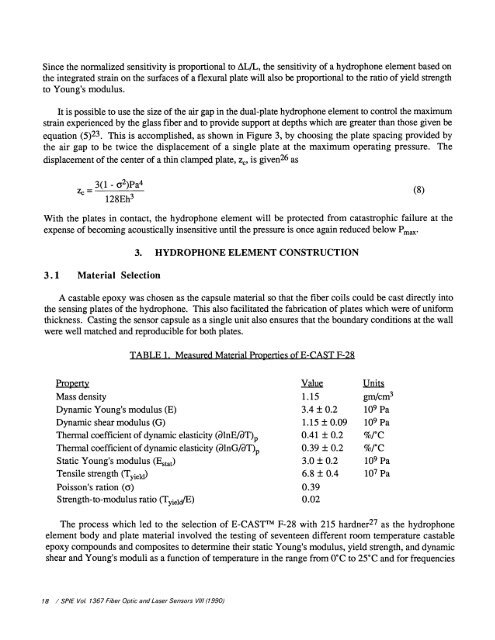A General Purpose Fiber-Optic Hydrophone Made of Castable Epoxy
A General Purpose Fiber-Optic Hydrophone Made of Castable Epoxy
A General Purpose Fiber-Optic Hydrophone Made of Castable Epoxy
Create successful ePaper yourself
Turn your PDF publications into a flip-book with our unique Google optimized e-Paper software.
Since the normalized sensitivity is proportional to AL/L, the sensitivity <strong>of</strong> a hydrophone element based on<br />
the integrated strain on the surfaces <strong>of</strong> a flexural plate will also be proportional to the ratio <strong>of</strong> yield strength<br />
to Young's modulus.<br />
It is possible to use the size <strong>of</strong> the air gap in the dual-plate hydrophone element to control the maximum<br />
strain experienced by the glass fiber and to provide support at depths which are greater than those given be<br />
equation (5)23. This is accomplished, as shown in Figure 3, by choosing the plate spacing provided by<br />
the air gap to be twice the displacement <strong>of</strong> a single plate at the maximum operating pressure. The<br />
displacement <strong>of</strong> the center <strong>of</strong> a thin clamped plate, z, is given26 as<br />
3(1 -<br />
zc=<br />
128Eh3<br />
(8)<br />
With the plates in contact, the hydrophone element will be protected from catastrophic failure at the<br />
expense <strong>of</strong> becoming acoustically insensitive until the pressure is once again reduced below 1max<br />
3.1 Material Selection<br />
3. HYDROPHONE ELEMENT CONSTRUCTION<br />
A castable epoxy was chosen as the capsule material so that the fiber coils could be cast directly into<br />
the sensing plates <strong>of</strong> the hydrophone. This also facilitated the fabrication <strong>of</strong> plates which were <strong>of</strong> uniform<br />
thickness. Casting the sensor capsule as a single unit also ensures that the boundary conditions at the wall<br />
were well matched and reproducible for both plates.<br />
TABLE 1. Measured Material Properties <strong>of</strong> E-CAST F-28<br />
Property<br />
Mass density<br />
Dynamic Young's modulus (E)<br />
Dynamic shear modulus (G)<br />
Thermal coefficient <strong>of</strong> dynamic elasticity (lnE/aT)<br />
Thermal coefficient <strong>of</strong> dynamic elasticity ()lnG/aT)<br />
Static Young's modulus (Estat)<br />
Tensile strength (Tyjeld)<br />
Poisson's ration ()<br />
Strength-to-modulusratio (TyjeidE)<br />
Value<br />
1.15<br />
3.4 0.2<br />
1.15 0.09<br />
0.41 0.2<br />
0.39 0.2<br />
3.0 0.2<br />
6.8 0.4<br />
0.39<br />
0.02<br />
Units<br />
gm/cm3<br />
iO Pa<br />
10 Pa<br />
%/°C<br />
%/°C<br />
10 Pa<br />
10 Pa<br />
The process which led to the selection <strong>of</strong> E-CAST F-28 with 215 hardner27 as the hydrophone<br />
element body and plate material involved the testing <strong>of</strong> seventeen different room temperature castable<br />
epoxy compounds and composites to determine their static Young's modulus, yield strength, and dynamic<br />
shear and Young's moduli as a function <strong>of</strong> temperature in the range from 0°C to 25°C and for frequencies<br />
18 / SPIE Vol. 1367 <strong>Fiber</strong> <strong>Optic</strong> and Laser Sensors VIII (1990)

















